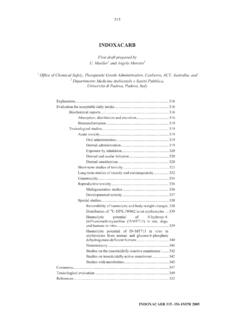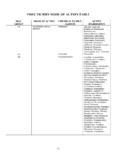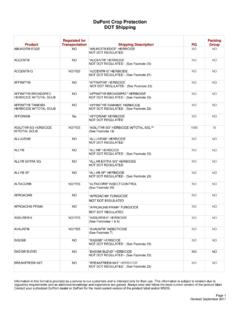Transcription of Tuta absoluta profile
1 October 16, 2009 tuta absoluta Insect profile tuta absoluta is a devastating pest of Tomato. It is originated from South America. Recently tuta absoluta considered to be a serious threat to tomato production in Mediterranean region. The newly introduced pest from south America finding the shores of the Mediterranean a perfect new home where it can breed between 10-12 generations a year. Each female can lay 250-300 eggs in her life time. This pest is crossing boarders and devastating tomato production both protected and open fields.
2 The infestation of tuta absoluta also reported on potato, Aubergine and common beans. tuta absoluta is a very challenging pest to control. Effectiveness of chemical control is limited due to insect s nature of damage as well as its rapid capability of development of insecticide resistant strains. The use of biological factors are still largely under development and not ready to combat this pest effectively and in a cost effective way. Sex pheromone trap is using as an early detection tool.
3 Mass trapping and lure and Kill application of pheromone has been found to be effective to control tuta absoluta . IPM strategies are being developed in South America to control tuta absoluta . Various active substances can be applied in combination with bio-rational control tactics Biology of tuta absoluta tuta absoluta is a micro lepidopteron moth with high reproductive potential. There are about 10 12 generations per year. The total life cycle is completed with in 30-35 days.
4 Adults are nocturnal and hide between leaves during the day time. Adults are 5-7 mm long and with a wingspan of 8-10 mm. Adult females lay eggs on host plants and. mature female could lay up to 260 eggs before completing life cycle. Eggs are Small cylindrical, creamy white to yellow mm long. Egg hatching takes place 4-6 days after egg lying. The Larvae is cream in colour with characteristic dark head. Four larval instars develop. Larvae do not enter diapause when food is available.
5 Pupation may take place in the soil, on the leaf surface or within mines. tuta absoluta can overwinter as eggs, pupae or adults depending on environmental conditions. The most important identifying character are the filiform (bead like structure) antenna, silverfish-grey scales and characteristic black spots present in anterior wing. The larvae becoming greenish to light pink in second to fourth instars. Larval period is most damaging period which completed with in 12-15 days.
6 October 16, 2009 Nature of damage The larvae of tuta absoluta mine the leaves producing large galleries and burrow into the fruit, causing a substantial loss of tomato production in protected and open filed cultivations. The larvae feed on mesophyll tissues and make irregular mine on leaf surface. Damage can reach up to 100%. This pest damage occurs throughout the entire growing cycle of tomatoes. tuta absoluta has a vey high reproduction capability. There are up to 10-12 generations in year in favourable conditions.
7 The larvae are very unlikely to enter diapause as long as food source is available. tuta absoluta can overwinter as eggs, pupae and adults. Adult female could lay hundreds of eggs during her life time. Tomato plants can be attacked from seedlings to mature plants. In tomato infestation found on apical buds, leaves, and stems, flowers and fruits, on which the black frass is visible. On potato, mainly aerial parts are attacked. However damage on tuber also recently reported. tuta absoluta reduced yield and fruit quality of Tomato grown in green house and open field.
8 Severely attacked tomato fruits lose their commercial value. 50 100% losses have been reported on tomato (EPPO, 2005). On potato, CIP (1996) considers that is one of the major pests of foliage, occurring in warm zones of low altitudes (below 1000 m). As larvae are internal feeders it is difficult to achieve an effective control through application of chemical insecticides. Moreover, tuta absoluta can rapidly evolve strains with reduced susceptibility to insecticides that have been previously effective.
9 Failure by synthetic insecticides has also been reported in many countries. October 16, 2009 Geographical distribution tuta absoluta is originated from South America. It is a serious pest in South America since the 80 s and distributed in Argentina, Bolivia, Brazil, Chile, Colombia, Ecuador, Paraguay, Peru, Uruguay, Venezuela (EPPO, 2005). Since the first detection in Spain in 2006, this pest is spreading rapidly across Southern Europe and North Africa to engulf the whole of the Mediterranean countries.
10 Until today the presence of tuta absoluta has been reported in Italy, France, Malta, United Kingdom, Greece, Switzerland, Portugal, Morocco, Algeria, Tunisia, Libya and Albania during last two years. [According to EPPO (2008b) EPPO (2008c), EPPO (2008d), EPPO (2009a), EPPO (2009b), EPPO (2009c), EPPO (2009d) and FERA (2009)]. October 16, 2009 Distribution map in Mediterranean region: Red mark locations indicating the presence of tuta absoluta . Control of tuta absoluta Various control strategy could applied to control tuta absoluta .






